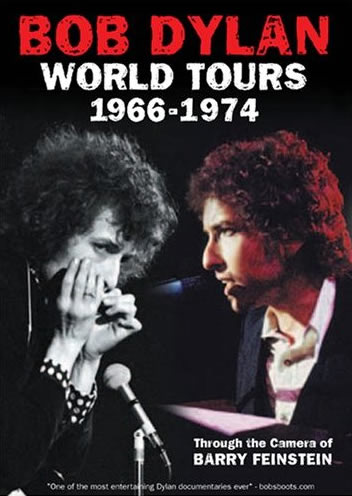Movies

New Releases • A-D • E-H • I-P • Q-Z • Articles • Festivals • Interviews • Dark Knight • Indiana Jones • John Wick • MCU
Bob Dylan: World Tours 1966-1974 (DVD)
Directed by Joel Gilbert
Joel Gilbert's second foray into "Dylanology" is far more successful than his first, but Bob Dylan World Tours 1966-1974 is still no Eat the Document.
Rockarazzi

Barry Feinstein was Dylan's sole photographer during his 1966 and 1974 world tours. Accompanied by some 150 of his Dylan photos, Feinstein takes Gilbert – and viewers – on a trip down memory lane.
One of the biggest problems with Gilbert's previous DVD documentary, Bob Dylan World Tour 1966: The Home Movies, was the production's extremely limited scope, a thin pastiche relying exclusively on drummer Mickey Jones's stories and home movies made during the historic "gone electric" tour. They were home movies that rarely showed Dylan himself and the entire DVD seemed to be a cheap way to cash in on Dylan's enduring appeal. After all, even now, Dylan is perpetually on the road, endlessly touring.
This time, the borders are opened and, thankfully, other inhabitants of Dylan's world are allowed to participate, making for a far more rounded and involving look at the rock icon. Also, Gilbert takes his own trips to Woodstock and Greenwich Village, allowing for some fluffy travel footage along the way.
But that's not to slight Feinstein. He's had an interesting career, one that allowed him to photograph the likes of Marilyn Monroe, Steve McQueen, Frank Sinatra, Janis Joplin, Richard Nixon, and Jimmy Carter. He certainly has plenty of worthwhile experiences to share, but in this case the focus is on Dylan and Gilbert asks his questions in such a direct, premeditated way, it feels as if he already knows the answers. Then again, he probably does.
Gilbert, who is quick to plug Highway 61 Revisited, the world's "only" Bob Dylan tribute band, of which he is the lead singer, is a pleasant enough chap, but he's simply not talk show host material.
Doing more harm than good to this well-meaning DVD is Gilbert's hokey re-enactment of Dylan's 1966 motorcycle accident amid speculative interviews as to what happened and how badly Dylan was hurt. Some argue Dylan faked it as an excuse to take a break from the rigors of touring and the demands on his talent. Amid such questionable circumstances, cheesily driving a motorcycle – and gently placing it on its side on a dirt road – is not the stuff of thrilling drama.
Free Bob Dylan!
Helping to make 1966-1974 enjoyable are some very good Dylan anecdotes. Notably, it was in Colorado where Dylan heard one of his songs on the radio for the first time; but Colorado was also the location for Dylan getting fired from a job as a piano player for a stripper in Central City.
Also, the owner of a coffee shop in Woodstock gets to not-so-sheepishly admit that she would not allow an exuberant, young Dylan to play a brand new song he had just written in her shop.
More significant are interviews with the legendary filmmaker D.A. Pennebaker, who made the equally legendary Dylan film Eat the Document, and the "godfather of rock journalism," Al Aronowitz. They add substance, weight, and additional perspective to the Dylan phenomenon.
Taking the cake, though, is A.J. Weberman. It's only a question of how mad this madman is. In 1960s New York, he ran a marijuana delivery service (after all, Weberman states, Mary Jane is an herb, not a drug).
The founder of "Dylanology," the scientific study of Dylan's poetry, he seems to get off on adding "-ology" to a lot of words, including "garbology." Yes. Weberman proudly declares himself to be the first private citizen to go through other people's garbage (in this case Dylan's) in order to unlock the mysteries of their life and lifestyle. As he authoritatively notes, journalists do it all the time now.
As off the wall as he sounds, he still reveres Dylan to this day, even after causing the star plenty of grief in the early going. "The dude is a walking unabridged dictionary," Weberman proclaims of Dylan, further noting that "Shakespeare was the Dylan of his time."
Oh. And Weberman was the first person to play songs backwards. He wasn't looking for Satanic codes or other subliminal messages; he was trying to unlock the mysteries of all things Dylan in hopes of discovering the "Dylan Rosetta Stone."
The material with Weberman is from so far out in left field, it's a complete change of pace from the respectful, reverential tone set by everybody else in the production. Nonetheless, his shtick does get tiresome. But, bless him, he's the sort of crank that makes life interesting for everybody.
DVD Extras
There are some decent, although not terribly exciting, bonus materials. At the top of the list is a nice little interview with Bruce Langhorne, Mr. Tambourine Man himself. There's also an interview with Izzy Young, who ran the Folklore Center. Both are given their chance to tell their Dylan stories and they appear as supplemental features because they just didn't fit in with the rest of the show's content.
There are also the to-be-expected photo galleries. Trouble is there is no step option for viewers to sift through the photos at their own pace.
Picture and Sound
There's nothing spectacular to note on the DVD's production quality. The video is standard direct-to-video fare and the sound is boring old two-channel stereo.
• Originally published at MovieHabit.com.


